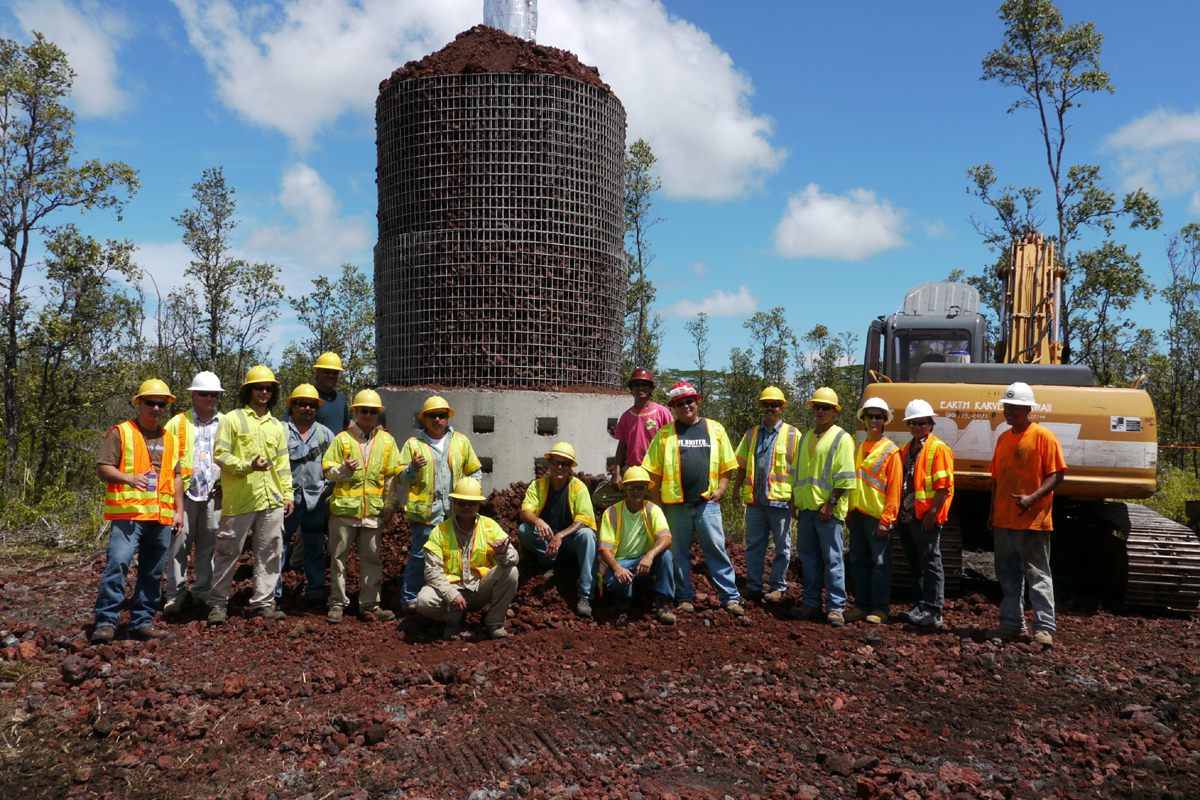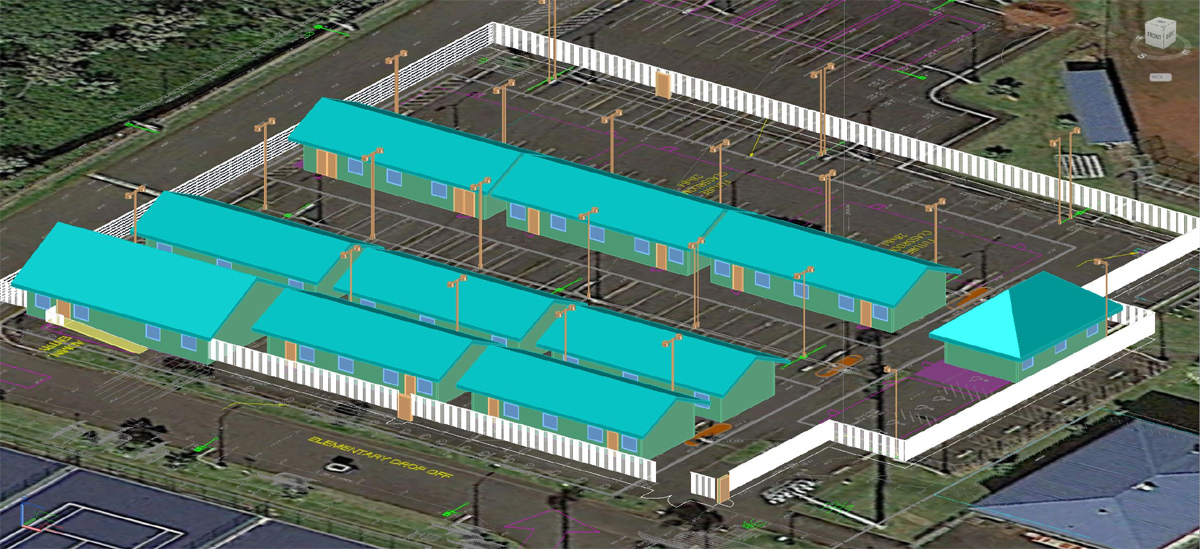(ABOVE VIDEO) The presentation made by Civil Defense head Darryl Oliveira to the Hawaii County Council Committee on Public Safety and Mass Transit during a meeting held on Tuesday (Sept. 30). Video by David Corrigan
NEWS BRIEFS
- Hawaii County Civil Defense administrator Darryl Oliveira talked about the different lava response missions that the county has identified going forward in an effort to try to “provide the community which as much normalcy as we can.” He said the mission priorities were established after hearing residents wanted to be able to stay in the Puna area, even if Highway 130 gets cut off by lava.
- On Roads, Oliveira says alternate access has already been established through both the Old Government Beach Road and Railroad Avenue. Railroad is a two-lane, all-weather surface. The packed gravel “ought to be able to accommodate buses as well as large commercial vehicles,” Oliveira said. Old Government Beach Road is a single lane with pullouts which means, “traffic could move in directions, provided that the drivers a courteous and allow each other to pass.” Beach Road won’t be able to accommodate large buses or large commercial vehicles, Oliveira said. The third alternate access route is Chain of Craters Road, a project that is only just beginning.
- Oliveira said the Hawaii Electric Light Company is committed to finding as many solutions as possible to provide for uninterrupted power service. HELCO is also the lead on other communications preparations, since the power utility owns the infrastructure that many of the other companies rely on.
- Oliveira said that for residents who rely on county water – and should existing water lines get cut by lava – the Department of Water Supply is ready to reestablish the Pahoa, which is located right behind the Pahoa High School, as well as possibly tap into their Mountain View source.
- The police and fire department have already identified their contingency plans to provide for an adequate workforce on the possible isolated side of the lava flow. The county has already requested – through state civil defense – National Guard assistance for “when the time comes”.
- The Department of Health is working closely with Bay Clinic and Puna Community Medical Center, as well as area pharmacies, to provide continued access to health care services. The county has also requested the state put DMAT – the Disaster Medical Assistance Team – on notice in the event a triage site needs to be set up on a mobile basis.
- The Department of Education has identified and developed a response plan for student redistribution.
- Oliveira said, “is going to be a very frustrating process going forward. As we’ve seen, the flow has taken so many different starts and stops. Its rate of movement has changed frequently. Right now, it’s to the point where the scientists saying it’s too early and too difficult to forecast – with any certainty – what’s the expected time or date at which this could play out, and eventually affect residential areas or even the highways. Just because the rate has been so inconsistent. We’re obviously going to be planning for the worst case scenario hoping for the best.”
PRIMARY SOURCES
Here are a number of updates Big Island Video News has been given by different entities on their ongoing lava flow preparations.

The company continues to work with Hawai‘i County Civil Defense and other agencies to monitor and evaluate the flow and is prepared to respond. Because of the unpredictable nature of the flow, Hawai‘i Electric Light has developed several plans to keep the power on and will put into action the plan that best fits the situation. The safety of employees and community is always the top priority.
“Our plans are based on key objectives that include keeping employees and the community safe and keeping the power on for our customers as long as is safely possible,” said spokesperson Rhea Lee. “In developing our plans, we consulted with volcanologists, Hawai‘i County Civil Defense and other County agencies, leaders in the Hawaiian community, and other partners.”
Plans include, but are not limited to:
- Protecting power poles from the heat generated by the lava by partially encasing select wooden poles with heat resistant and dispersive material;
- Increasing the distance between select power poles to span the lava flow;
- Extending our distribution lines on Government Beach Road and other areas as an alternate means to provide power to Puna subdivisions should the normal power distribution lines become inoperable.
- Relocating generators to the Puna District to provide an alternate source of generation should the flow isolate the area from the island-wide power grid.
Last week, crews started work on Government Beach Road. In addition, pole protection prototypes were built in the Puna area.
“There is a lot of focus on protecting poles as a means to retain the current transmission and distribution system,” Lee said. “The designs developed are experimental, but we are hopeful that they will be successful and can be used on select wooden poles as the lava progresses.”
In addition, Hawai‘i Electric Light is exploring the possibility of operating a micro-grid in the event the lava flow isolates lower Puna from the power system.
“A micro-grid is disconnected from the utility grid and generates power for a specific area,” Lee said. “This option may allow us to continue to provide power to the lower Puna community until we are able to rebuild transmissions lines that are damaged by lava and interconnect these lines to the grid.”
However, outages may occur despite efforts to keep the power on for as long as possible. As the flow gets closer to our facilities, we will provide more specific information as to how customers could be impacted.
For customers who evacuate, the company recommends:
- Shut off electricity at the main breaker or switch;
- Unplug or turn off electric equipment and appliances;
- Call Customer Service at 969-6999 to request a service disconnect or transfer.
Hawai‘i Electric Light’s free “Handbook for Emergency Preparedness” provides detailed information on preparing for emergency situations. The handbook is available in English, Cantonese, Ilocano, Korean, and Vietnamese and can be found at the company’s business offices, on its website www.hawaiielectriclight.com, or by calling 969-0137.
As there are new developments, updates will be provided to the media and public and also posted on Hawai‘i Electric Light’s website, Twitter, and Facebook accounts.HELCO media release on Oct. 3, 2014

Photo by Hawai‘i Electric Light Company”. HELCO employees install protection around a utility pole in the Puna area using heat resistant and dispersive material.

The Hawai‘i State Department of Education (DOE) continues to work on contingency plans for public schools, students and staff in preparation for lava to eventually cross Pahoa’s Highway 130. The lava flow stalled Sunday on its approach toward Pahoa town. However, volcanic activity is ongoing.
“We are doing our best to keep a sense of normalcy in our schools and we stand ready to adjust our operations as needed,” stated Mary Correa, complex area superintendent for Ka‘u, Kea‘au, Pahoa.
Given the information from the subject-area experts, the DOE is committed to doing what is necessary to allow public school teachers and students to continue teaching and learning. This includes preparing for the potential loss of an elementary school. The DOE is building an alternate site for elementary students in the Kea‘au High lower parking lot that could hold a number of classrooms. The site would accommodate at least 17 classrooms and up to 500 students and staff. The initial estimated cost to the DOE is $9 million.
“We believe that setting up an alternate site is necessary in order to ensure that our teachers and students have everything ready should we lose a school,” stated Superintendent Kathryn Matayoshi. “We continue to tackle a number of scenarios and we appreciate the flexibility of our staff, the cooperation of our families, and the collaboration with Hawai‘i County agencies in our preparation efforts.”
Based on the expectation that access to Keonepoko Elementary, Pahoa High & Intermediate, and Pahoa Elementary will be compromised, plans are being made for students who reside north of the flow to be rerouted to the Kea‘au complex when the flow crosses Highway 130. Students who reside south of the flow will remain in their homeschools if those facilities are not negatively impacted.
“When the lava crosses the highway, we want to make sure everything is in place in order to provide continued school services,” said Correa.
Pahoa complex currently has an estimated 1,800 students and roughly 300 employees.
Plans have been shared with parents at all three schools via letters and school meetings. Besides student planning, the DOE is also initiating plans that would guide affected employees on necessary changes. Earlier this month the DOE asked parents and staff who may have changed their residence to immediately update their contact information with school administrators. Dept. of Education on Sept. 25, 2014

A rendering of the alternate site plan, courtesy the DOE.
Finally, some Frequently Asked Questions on 2014 Puna Lava Flow Emergency & Drinking Water, put together by the Hawaii County Department of Water Supply.
What will happen to the DWS water system if lava flows over Highway 130? The DWS system has source and storage sites on both sides of Pāhoa town. If the lava continues on the projected path, we plan to close valves on both sides of the flow which will allow us to retain continued service on either side. In other words, our system will continue to be active on either side of the flow.
What about the water spigots? As described above, based on the projected path, we expect to continue water service including the spigots located on the main highway before Pāhoa town and the spigots at the entrance to Nānāwale.
What about Kapoho area? Kapoho as well as Pohoiki, Nānāwale, and Lanipuna are serviced by our Pāhoa system. As described above, we expect to continue water service including those areas.
When will the Pāhoa well repair be completed? September 28, 2014. If the lava flow impacts our system prior to that date, we will haul water from our Kalapana system, which is a separate system with its own sources, to our Pāhoa system.
Will Kalapana be affected? Kalapana is a separate water system with its own source, storage and pipelines. Based on the projected path of the flow, we don’t anticipate Kalapana being affected.
What if power goes out? We have generators and fuel for our well sites in case of an extended power outage. Water use should be limited to essential needs only to insure continued water service to as much of the community for as long as possible.
What about the water system in Hawaiian Beaches & Hawaiian Shores? Although those are private water systems, we have a mutual understanding that we will help each other out in times of emergency. So, if their system is affected and we are able to, we will coordinate a way to connect our system to theirs to provide water. Similarly, if our system is affected and they have a way of assisting us, they will do so.
If I need to evacuate my home, what should I do regarding my water service/meter? As part of your preparations to evacuate, the DWS recommends you take precautions with appliances connected to your water system prior to closing the valve located inside your meter box. Call (808) 961-8790 for any follow up questions you may have for your account.
If Pāhoa Post Office closes, where will I receive my bills? You can request a change of billing address from the DWS to ensure uninterrupted bills, or, you can work with the U.S. Postal Service regarding alternate mail delivery plans for your area.Department of Water Supply

by Big Island Video News12:01 am
on at
STORY SUMMARY
Roads, electricity, health care, public safety and education are adjusting in order to be prepared.